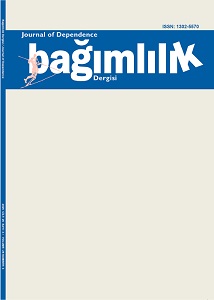INTRAVENOUS LİPİD EMULSİON AS A TREATMENT OF SİNUS TACHYCARDİA INDUCED BY SYNTHETİC CANNABİNOİD INTOXİCATİON: TWO CASE REPORTS
Keywords:
Synthetic cannabinoid, sinus tachycardia, intravenous lipid emulsionAbstract
Synthetic cannabinoid usage has been gradually increasing. Intoxication related to synthetic cannabinoid usage is becoming more common, and life-threatening cases are encountered in the general hospitals and psychiatry emergency services. Unlike cannabis, acute intoxication symptoms of synthetic cannabinoid are similar to the effects of stimulants and sympathomimetic usage. During synthetic cannabinoid usage, side effects such as diaphoresis, nausea, vomiting, appetite changes, hyper/hypotensi-on, chest pain, tachycardia/bradycardia, respiratory depression, confusion, psychomotor agitation, somnolence and sedation can be seen. The most common physical side effect is tachycardia. In this report, two cases of sinus tachycardia induced by synthetic cannabinoid usage, which were treated with intravenous lipid emulsion, were discussed.
References
Evren C, Bozkurt M. Sentetik kannabinoidler: Son yılların krizi. Düşünen Adam Psikiyatri ve Nörolojik Bilimler Dergisi 2013; 26: 1-11.
Vardakou I, Pistos C, Spiliopoulou CH. Spice drugs as a new trend: Mode of action, identification and legislation. Toxicol Lett 2010; 197:157-162.
Wood DM, Dargan PI. Novel psychoactive substances: How to understand the acute toxicity associated with the use of these substances. Ther Drug Monit 2012; 34: 363-367.
Hoyte CO, Jacob J, Monte AA, et al. A characterization of synthetic cannabinoid exposures reported to the National Poison Data System in 2010. Ann Emerg Med 2012; 60: 435-438.
Schneir AB, Cullen J, Ly BT. “Spice” girls: synthetic cannabinoid intoxication. J Emerg Med 2011; 40:296-299.
Suzer MA, Ozhan MO, Eskin MB, Atik B, Caparlar C. Local Anesthetic Toxicity Managed Successfully with Lipid Infusion (Case Report). Türk Anest Rean Der Dergisi 2011; 39 (3): 159-163.
Jamaty C, Bailey B, Larocque A, et al. Lipid emulsions in the treatment of acute poisoning: a systemic review of human and animal studies. Clin Toxicol 2010; 48:1-27.
Cave G, Harvey M. Intravenous lipid emulsion as antidote beyond local anaesthetic toxicity: A systematic review. Acad Em Med 2009; 16: 815-824.
Bozkurt M. Sentetik kannabinoidler: Artık herkesin sorunu. Psikiyatride Güncel 2014; 4: 165-77.
Hermanns-Clausen M, Kneisel S, Szabo B, Auwarter V. Acute toxicity due to the confirmed consumption of synthetic cannabinoids: Clinical and laboratory findings. Addiction 2013; 108: 534-44.
Spaderna M, Addy PH, D’Souza DC. Spicing things up: Synthetic cannabinoids. Psychopharmacology 2013; 228:525-40.
Simmons J, Cookman L, Kang C, Skinner C. Three cases of “spice” exposure. Clin Toxicol 2011; 49: 431-3.
Rothschild L, Bern S, Oswald S, Weinberg G. Intravenous lipid emulsion in clinical toxicology. Scand J Trauma Resusc Emerg Med 2010; 18: 51.
HarveyM, CaveG: Intralipid out performs sodium bicarbonate in a rabbit model of clomipramine toxicity. Ann Emerg Med 2007, 49: 178-185.
Finn SD, Uncles DR, Willers J, Sable N. Early treatment of a quetiapine and sertraline overdose with Intralipid. Anaestehesia 2009; 64(2):191-4.
Downes M, Page C, Isbister G. Response to “use of lipid emulsion in the resuscitation of a patient with prolonged cardiovascular collapse after overdose of bupropion and lamotrigine”. Ann Emerg Med 2008; 51(6):794-5; author reply 795.
Carreiro S, Blum J, Hack JB. Pretreatment with intravenous lipid emulsion reduces mortality from cocaine toxicity in a rat model. Ann Emerg Med 2014; 64(1):32-7.
Fettiplace MR, Ripper R, Lis K, et al. Rapid cardiotonic effects of lipid emulsion infusion. Crit Care Med 2013; 41(8):156-62.
Presley JD, Chyka PA. Intravenous lipid emulsion to reverse acute drug toxicity in pediatric patients. Ann Pharmacother 2013; 47(5):735-43.
Corman SL, Skledar SJ. Use of lipid emulsion to reverse local anesthetic-induced toxicity. Ann Pharmacother 2007;41(11):1873-7.
Leskiw U, Weinberg GL. Lipid resuscitation for local anesthetic toxicity: Is it really lifesaving? Curr Opin Anaesthesiol 2009; 22: 667-71.
Downloads
Published
How to Cite
Issue
Section
License
Copyright (c) 2025 Journal of Dependence

This work is licensed under a Creative Commons Attribution-NonCommercial-NoDerivatives 4.0 International License.
...
